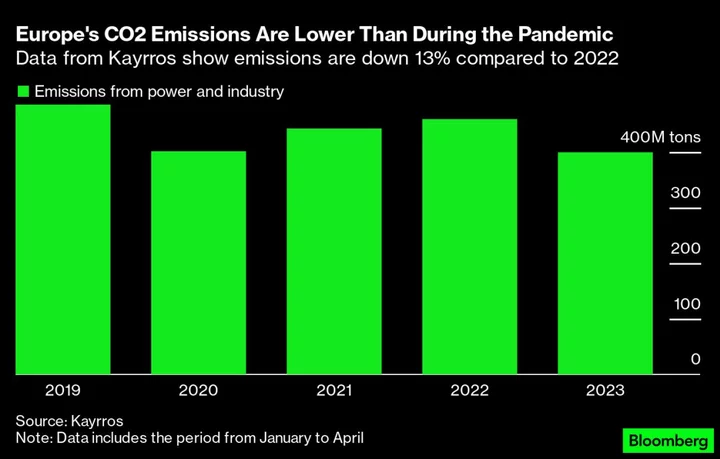Europe’s carbon emissions from power plants and industry have been even lower to start the year than they were during the depths of the pandemic as high energy prices and strong renewable output slash demand for fossil fuels.
Emissions from power plants and industrial operations covered by the European Union’s cap-and-trade system are down 13% in the first four months of the year, according to data from geoanalytics firm Kayrros SAS. The roughly 400 million metric tons of CO2 produced in that period was slightly lower than in the start of 2020, when pandemic restrictions had come into effect.
While part of the emissions drop can be attributed to a ramp up in new renewable power sources, another big factors is the steep decline in demand from industries that can no longer afford to operate at normal levels. Even as natural gas prices are down from last year’s eye-watering records, the drop in emissions to below a level when much of the European economy was shuttered to contain the coronavirus is a sign that the impacts of the energy crisis are far from over.
“Industry is moving out or shutting down,” said Andreas Gandolfo, analyst at BloombergNEF. “Industry accounts for so much of emissions and industry is shifting out of Europe because of how high energy prices are.”
While benchmark European natural gas prices are about a third what they were a year ago, when Russia’s invasion of Ukraine sent the market soaring, they’re still roughly double the level from 2019. That’s proved too much for swathes of European industry. Chemical producers reported a 15% drop in first-quarter output compared with a year earlier, according to data from trade body VCI.
In response to the Ukraine invasion, European leaders vowed to cut dependence on Russian gas. In the short term, governments tried to cut demand. And for the long term, they promised to speed up the deployment of renewables to replace fossil fuels for good.
Read More: G-20 Countries Avoid Climate Backslide Despite Rush for Energy
So far this year, both of those objectives are coming to fruition in the EU’s power mix. Across the bloc, electricity from fossil fuels has plunged nearly 16% compared with a year ago, according to data from climate think-tank Ember. That includes a 17% drop in power from coal-fired plants and a 15% decline from gas-fired ones.
Renewables have surged this year, mostly boosted by strong wind production. Overall, wind, solar and hydro power plants accounted for a larger share of the EU’s power mix in the first four months than all the fossil-fuel burning ones.
Some countries have also seen record solar power generation, even though the technology performs better during the summer when the sun is stronger and days are longer. Portugal produced more than half its electricity from solar panels for the first time in April, Ember found.
(Adds chart after seventh paragraph)

